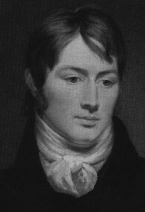The painter John Constable was born on June 11, 1776 in East Bergholt,
Suffolk. Until 1799 he worked in the shop of his father, Golding
Constable, but then entered the Royal Academy in London, where he became
a student of Joseph Farington. He was strongly influenced by Jacob van
Ruisdael and Claude Lorrain, before he found his own style of painting,
based on the immediate observation of nature.
In spite of his
studies at the academy, John Constable largely remained self-taught. In
1802 Constable had his first exhibition in London. That same year, he
bought a studio in his home town. In 1809 he met his future wife, Maria
Bricknell, the daughter of a civil servant. In 1816, one year after his
mother's death, Constable married Maria Bricknell, with whom he had 7
children. John Constable was particularly interested in landscape
paintings, in which he tried to capture the phenomena and the
variability of nature.
Initially, John Constable's paintings only
seemed to meet with little interest in England. After he had
participated in the Paris Salon, however, they became very successful in
France. Constable's picture "The Hay Wain", which was shown at the
Paris Salon, for example, influenced Delacroix's palette.
With an
animated brush stroke and spatula, John Constable tried to capture the
atmosphere of the moment, thereby anticipating the Impressionists'
interpretation of nature. In 1824 John Constable even received a gold
medal from the French king. Among his most important works are "Malvern
Hall" (1809) and "The Cornfield" (1826). Constable's series of
watercolors are also very famous.
John Constable is regarded as the
most important English landscape painter of the 19th century, at a par
with William Turner. On November 23, 1828, Maria died from tuberculosis
at the age of 41.
John Constable died unexpectedly in the night of March 31, 1837
A portrait of Maria Bicknell
painted in 1816 by John Constable
Constable Country is a small
area along the valley of the river Stour consisting of East Bergholt, Flatford
and Stratford St Mary on the Suffolk side and Dedham and Langham on the Essex
side. Throughout his life Constable kept returning to scenes he loved around
this small area. To this day much of the countryside would easily be recognised
by Constable, and at Flatford, (now owned by the National Trust), the sites of
seven of his major paintings can be located with precision. One problem with
seeing the views is that there are far more trees today than there were 200
years ago!
Constable painted a number
of pictures from the top of the hill by Langham Church, usually looking along
the Stour Valley. Some of these paintings
are:
Painted in about 1800 this shows the view towards Stratford St Mary
This was called The Glebe Farm and was painted in 1830
In
many of Constable’s paintings barges appear on the river and they were a major
feature of the river 200 years ago. Following an Act of Parliament in 1705 the
Stour had been made navigable from the coast, at Manningtree, up to Sudbury.
The main purpose of the barge traffic was to take coal up to Sudbury returning
with bricks and agricultural produce from the mills. The Stour Navigation was
very successful during the late 18th century and early 19th century but after
the coming of the railways it declined although it did continue until the first
World War. The picture above is a good example of the Constable's attention to
detail and his very accurate presentation of trees, sky and the posture of the
people.






No comments:
Post a Comment